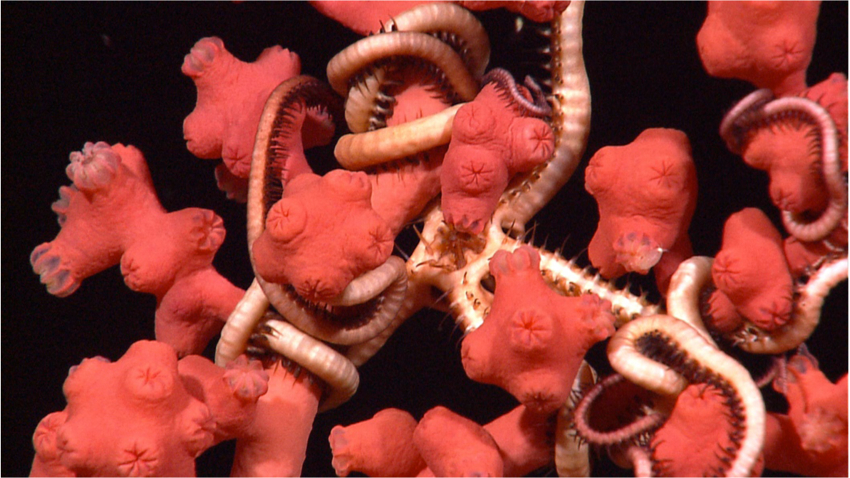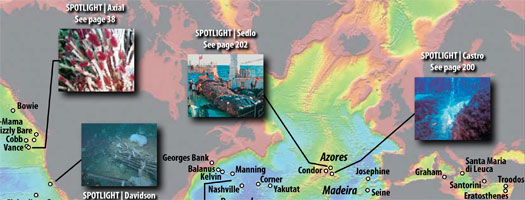Indonesia expedition maps rich undersea life
A joint Indonesian–U.S. expedition in the Sulawesi Sea mapped at least 25 different types of undersea habitats and may have discovered dozens of new species, scientists announced here December 13 at the American Geophysical Union meeting. Among the candidates for new species, which were photographed this summer using a remotely operated vehicle (ROV), was this…
Read MoreThe Coral Triangle’s dark secret: Life thrives in the deep
Between the Indonesian islands that arc north towards the Philippines, the ocean floor is pockmarked with deep basins and underwater volcanoes. It is an area where oceanic currents collide, tectonic plates die, and species burst forth in a proliferation rarely seen elsewhere on Earth. The shallow areas are best known as the Coral Triangle, where…
Read MoreU.S. and Indonesian Scientists Find Biodiversity Runs Deep in Sulawesi Sea
New submarine volcanoes, a large hydrothermal field with a thriving exotic animal ecosystem and areas rich with deep-sea ocean animals are among the discoveries reported today by U.S. and Indonesian scientists who explored the largely unknown deep Sulawesi Sea last summer off the coast of Indonesia. Read more …
Read MoreDeep-sea images reveal colorful life off Indonesia
Scientists using cutting-edge technology to explore waters off Indonesia were wowed by colorful and diverse images of marine life on the ocean floor _ including plate-sized sea spiders and flower-like sponges that appear to be carnivorous. They predicted Thursday that as many as 50 new plant and animal species may have been discovered during the…
Read MoreOceanography: Death and rebirth in the deep
Richard Lutz, a marine biologist at Rutgers University in New Brunswick, New Jersey, and his colleagues were 2,500 metres beneath the ocean’s surface when they encountered the ‘blizzard’. It was April 1991, and an underwater ridge, 900 kilometres off the coast of Acapulco, Mexico, was splitting open, introducing 1,200 °C molten rock to 2 °C…
Read MoreMulticelled Animals May Live Oxygen-Free
The claim is startling and the evidence indirect, but marine biologists seem open to the idea that multicellular animals can live without oxygen. Three species of loriciferan, a creature that sounds and looks like something out of a Dr. Seuss book, appear to go their whole lives without oxygen, researchers report online April 6 in BMC…
Read MoreBriny deep basin may be home to animals thriving without oxygen
The claim is startling and the evidence indirect, but marine biologists seem open to the idea that multicellular animals can live without oxygen. Subscription needed: Read more …
Read MoreSeamounts Reach a Pinnacle in Upcoming Issue of Oceanography
Lying beneath the ocean is spectacular terrain ranging from endless chains of mountains and isolated peaks to fiery volcanoes and black smokers exploding with magma and other minerals from below Earth’s surface. This mountainous landscape, some of which surpasses Mt. Everest heights and the marine life it supports, is the spotlight of a special edition…
Read MoreMarine Scientists Discover Deepest Undersea Erupting Volcano
Scientists funded by the National Science Foundation (NSF) and NOAA have recorded the deepest erupting volcano yet discovered—West Mata Volcano—describing high-definition video of the undersea eruption as “spectacular.” “For the first time we have been able to examine, up close, the way ocean islands and submarine volcanoes are born,” said Barbara Ransom, program director in…
Read MoreCould Jupiter Moon Harbor Fish-Size Life?
In the oceans of a moon hundreds of millions of miles from the sun, something fishy may be alive—right now. Below its icy crust Jupiter‘s moon Europa is believed to host a global ocean up to a hundred miles (160 kilometers) deep, with no land to speak of at the surface. Read more …
Read More









